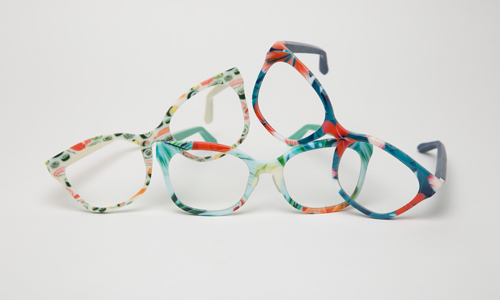As always, Vision Expo East was exciting with so much to see in product and services, as well as catching up with colleagues. Two new products really grabbed my attention, though, and I wonder if they might make the perfect combination for truly unique and custom eyewear. They are 3D printed frames and 3D printed lenses.
 Luxexcel developed the technology for 3D printed lenses in the Netherlands in 2009. They now have a facility in the US in Georgia. Rather than removing material from a lens blank by grinding to generate the lens power, 3D lens printing is “additive manufacturing.” A UV curable resin is deposited in droplets over several passes to create a completely customized lens. This process saves material, water and energy, too.
Luxexcel developed the technology for 3D printed lenses in the Netherlands in 2009. They now have a facility in the US in Georgia. Rather than removing material from a lens blank by grinding to generate the lens power, 3D lens printing is “additive manufacturing.” A UV curable resin is deposited in droplets over several passes to create a completely customized lens. This process saves material, water and energy, too. You can learn more about the process at www.luxexcel.com.
The ECP designs the lens using Luxexcel Vision Master software, and can create almost any lens design with custom positioned adds, specific base curves, prism, etc., in virtually any prescription. Luxexcel Vision Clear resin lenses have an Abbe of 45, and an index of 1.53. They can then accept hard coating, AR, UV, tints and mirror coats, the lenses can be etched with designs or logos, and can even be integrated into the frame design. Polarized and photochromic lenses will be generally available soon. Luxexcel has the technology to produce lenses with embedded sensors or screens that can track eye movements and respond to blinks. The possibilities seem endless!
Now consider teaming custom lenses with custom frames. Specsy, in Ontario, Canada, developed a 3D printed frames process about a year ago. ECPs use the Specsy augmented reality app to enable customers to design exactly the frame they want. They see their creations through a live video feed. You can experience the process yourself on their website specsy.com. Next, a 3D scanner and iPad take a 3D scan of the customer to select colors, patterns, which even can be from photographs, base curve and temple length (not just 140mm). Submit the order through the Specsy portal, and they return a rendering for final approval. The frame foundations are printed, then polished, buffed and assembled by hand. The entire process takes about a week. Currently, only plastic frames are available, but metals are in the pipeline.
Not only is custom designing a frame fun for the customer, consider the person who needs a custom fit. Bridges and temples that fit just right and are wide enough or narrow enough for any head size. Frames that can accommodate facial irregularities and have a look and style the customer enjoys. No one would have to consider just one or two styles or colors.
If you ever think that you’ve seen it all, or that our industry has reached its peak, think again. Innovators in our industry have always embraced technological advances in other industries, from materials to design to production. It’s our responsibility to keep up. We can do that through education, and you can get that education at 2020mag.com/ce.













